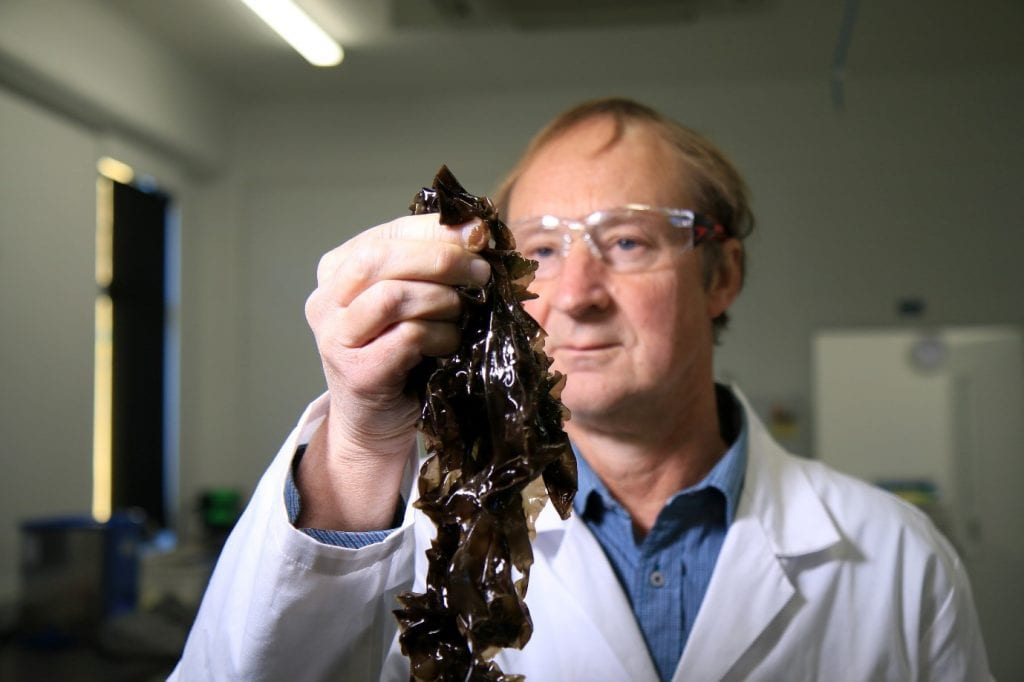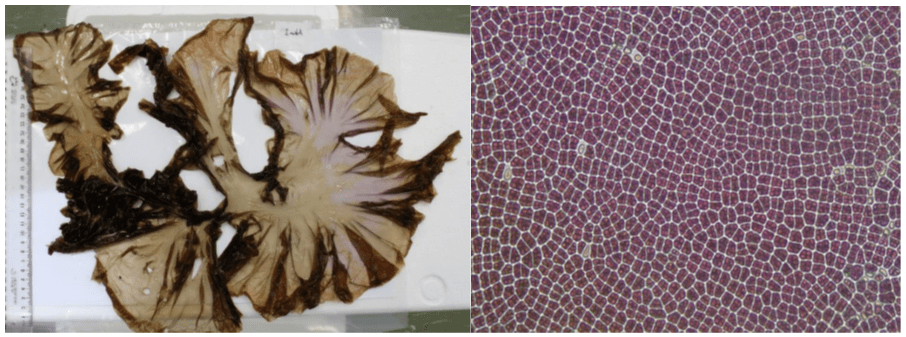New Zealand’s coasts produce a diversity of seaweeds, including a group collectively called Karengo. Long known to Māori as a traditional source of food, Karengo is now stirring up interest for its potential as a high-value food for aquaculture. From micronutrients to unique fats, seaweeds have been shown to contain a multitude of helpful components with anti-inflammatory and immunomodulatory activities, to name a few. The family of seaweeds comprising Karengo has yet to be examined for such properties, and very little is known about which species has the best nutritional properties and attributes for sustainable aquaculture. This lack of knowledge has prompted Te Rūnanga o Ngāi Tahu, Wakatū Incorporation, and the Cawthron Institute to team up on a collaborative project recently funded by the High-Value Nutrition National Science Challenge.
 Dr Tom Wheeler of Cawthron Institute displaying a sample of karengo.
Dr Tom Wheeler of Cawthron Institute displaying a sample of karengo.
Having the capability to reliably identify Karengo species on both a morphological (i.e., form and structure) and genetic basis is vital to future efforts in establishing Karengo’s nutritional value. For the last six months, the project team worked with Karengo samples to establish key analytical procedures for reliable species identification and bioactive composition analyses. Cawthron researchers Paul South and Rita Lee have been cataloguing Karengo samples, taking microscope slides and photos of cellular structure and, most importantly, completing a DNA sequence-based identification of each Karengo species. Morphologies of specimens analysed thus far were highly variable and genetic analyses identified 5 species and 2 genera from the 11 samples of Karengo analysed. Overall, there were two species in the genus Porphyra and 3 species in Pyropia. This initial work suggests there is a high diversity of Karengo species on the east coast of the South Island.
 Sample and microscopic structures of a Karengo species collected from Akaroa and identified as Pyropia cinnamomea.
Sample and microscopic structures of a Karengo species collected from Akaroa and identified as Pyropia cinnamomea.
The team’s plans for more structured and intensive sampling for the upcoming winter promises to reveal even greater diversity. With robust methods and analytical tools now established and in-hand, the team will systematically define bioactive compositional profiles, according to species as well as location. This work will help identify the most suitable species for aquaculture development and high-value food applications.
 Left: Bruce Rhodes from Onūku Marae showing Karengo seaweed growing along the Akaroa coast. Right: Donato Romanazzi, Tom Wheeler, and Aneika Young from Cawthron Institute join Teone Tainui from Onūku Marae in checking karengo growth in Akaroa.
Left: Bruce Rhodes from Onūku Marae showing Karengo seaweed growing along the Akaroa coast. Right: Donato Romanazzi, Tom Wheeler, and Aneika Young from Cawthron Institute join Teone Tainui from Onūku Marae in checking karengo growth in Akaroa.
Reliable identification of seaweed species is important to the project’s success, but the future of sustainable production and harvest of Karengo requires a shared understanding of its history and cultural value. The Cawthron team is working closely with commercial partners Te Rūnanga o Ngāi Tahu and Wakatū Incorporation to better understand Māori traditional uses of Karengo. Doing so has the benefit of helping to establish strong relationships with local communities where Karengo is traditionally harvested and used as valuable food. As part of this effort, Cawthron researchers and members of Ngāi Tahu and Wakatū visited Onuku Marae in Akaroa to meet local hapū. Meeting at Onuku Marae provided the opportunity to see how, where, and when local communities harvest Karengo and how it is traditionally prepared. It was also an opportunity for Cawthron scientists to share and socialise scientific objectives and the overall aim of the programme with local kaitiaki. Overall, the progress to date has established necessary analytical capabilities and laid the foundation for a strong relationship with Māori that will help enable success.